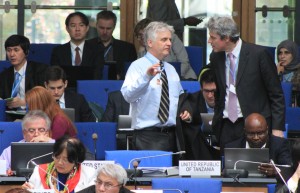Taking science seriously: the short-comings of the US approach to international climate action
The Bonn climate negotiations concluded on a historic achievement: they finished ahead of schedule. Two hours before the official end of the meeting, the co-chairs had managed to wrap-up the main points discussed this week and suspended the meeting for four weeks. Usually, such a final plenary session will often involve “fireworks” as frustrated delegations engage in a verbal joust. On Friday however, the negotiators seemed satisfied with the results of the past negotiating days and thus allowed the co-chairs to conclude the week ahead of schedule.
 I am however growingly concerned about one development of the talks during the past days. The negotiators of many countries have begun to consider how to accommodate the US intransigence. Building a strong legal framework might be a very impressive outcome; however it will have virtually no chance of being ratified by the US Senate thus making it impossible for the country to become a party to the legal agreement and leaving the door open for other conservative countries to follow suit. To avoid such a scenario, one could take the US position as a starting point, build on it to make it more ambitious and ensure that the country’s red lines are not crossed. Personally, I cannot help but fear however that, by leaving Capitol Hill defines the limits of what the world community can achieve, we will burry all chances to achieve emission reductions in line with the recommendations made by scientists. But before addressing the short-comings of this approach, let us begin by considering what the US proposes.
I am however growingly concerned about one development of the talks during the past days. The negotiators of many countries have begun to consider how to accommodate the US intransigence. Building a strong legal framework might be a very impressive outcome; however it will have virtually no chance of being ratified by the US Senate thus making it impossible for the country to become a party to the legal agreement and leaving the door open for other conservative countries to follow suit. To avoid such a scenario, one could take the US position as a starting point, build on it to make it more ambitious and ensure that the country’s red lines are not crossed. Personally, I cannot help but fear however that, by leaving Capitol Hill defines the limits of what the world community can achieve, we will burry all chances to achieve emission reductions in line with the recommendations made by scientists. But before addressing the short-comings of this approach, let us begin by considering what the US proposes.
Bottom-up
 The position of the United States is well articulated in its submission to the UN climate secretariat and can be summarized in two main points. First, the US expects “mitigation contributions” (the word that the US uses where others refer to “obligations” or “commitments”) from all countries - except perhaps for the least developed. Second, the country favors a bottom-up approach in which each country will be free to propose its own contributions. The scale of these contributions would be based on any “national circumstances” that the country considers relevant. A consultation period would then be organized during which parties and the public could compare and comment other countries’ submissions. Finally, countries will be offered the possibility to alter their proposals on the basis of these comments, but only if they so desire.
The position of the United States is well articulated in its submission to the UN climate secretariat and can be summarized in two main points. First, the US expects “mitigation contributions” (the word that the US uses where others refer to “obligations” or “commitments”) from all countries - except perhaps for the least developed. Second, the country favors a bottom-up approach in which each country will be free to propose its own contributions. The scale of these contributions would be based on any “national circumstances” that the country considers relevant. A consultation period would then be organized during which parties and the public could compare and comment other countries’ submissions. Finally, countries will be offered the possibility to alter their proposals on the basis of these comments, but only if they so desire.
The approach raises several issues, the US itself acknowledging that the effectiveness of such a proposal might be considered counter-intuitive by others.
Leaving the countries free of identifying any possible circumstance to justify their low ambition is likely to result in a race to the bottom as even most creative excuses are tolerated. Since I began to attend the climate negotiations in 2008, I heard countries put forward the following parameters as justifying lower actions: being too cold a country, being too hot a country, being too large, being too small, having too many natural resources, not having natural resources… The idea of involving peer-pressure to motivate countries to raise their own ambitions is an interesting concept. However, one can reasonably doubt that it will produce little results when it comes to the biggest bullies of the class (starting with the US). Thirdly, the lack of a review process highlighting to what extent parties should increase their ambition could even lead to the opposite result than is expected: having countries reducing their original contribution in order to reserve for themselves the possibility to increase their ambition if subjective conditions are gathered during the “peer-review” phase. If, for one reason or another, the country subjectively considers that these conditions are not met, it might thus end up being bound to a lower level of commitment than would otherwise have been the case under another approach. The EU adopted such a strategy in the lead up to the Copenhagen conference when it offered to reduce its emissions by an additional 10% if others would commit under an international agreement. As the EU failed to leverage additional engagement from other countries, it refused to accept for itself a more stringent target and remains bound to the inadequate 20% emissions reductions proposed in 2008.
From one gap to another?
But most concerning, there is absolutely nothing in this proposal that would guarantee that the sum of these contributions would match the level of ambition that is required to preserve chances of avoiding dangerous climate change.
The international climate community already tested this approach in 2009, as the US managed indeed to convince their partners that voluntary commitments were the solution to the Copenhagen deadlock. This proposal, also called “pledge and review “, was formally endorsed by the UN one year later in the Cancun agreements. Parties were invited to fill a table with whatever target they would feel adequate for the reduction of their emissions. This led to the jaw-dropping gap of 33 gt of carbon between the sum of the offers and the recommendation made by scientists.
 In this context, the only international review consists as verifying whether countries are matching the contributions that they committed to deliver. If the commitments proposed by countries do not match the level of action that scientists highlight as necessary to remain on a safe pathway, the review will only be able to confirm whether governments are policies are as inadequate as they suggested at first.
In this context, the only international review consists as verifying whether countries are matching the contributions that they committed to deliver. If the commitments proposed by countries do not match the level of action that scientists highlight as necessary to remain on a safe pathway, the review will only be able to confirm whether governments are policies are as inadequate as they suggested at first.
Taking science seriously
About half of the time spent by negotiators in the “Durban Platform” discussion (the current round of negotiations lasting between 2011 and 2015) is actually dedicated to seeking solutions to address the shortcomings of the pledge and review approach adopted four years ago. In this context, it is disturbing to witness the US and others arguing that we should replicate the same approach for the post 2020 timeframe. Einstein famously affirmed that “insanity consists in doing the same thing over and over again and expecting different results”.
If governments were sincere in their efforts to avoid dangerous climate change and were willing to pay more than lip-service its principles (among which the precautionary principle and intergenerational equity), they would need to have a serious discussion before 2015 to ensure that the sum of countries obligations does match expectations led out based on the latest science - something that is lacking from the US proposal. Luckily, the release over the coming months by the IPCC of its fifth assessment report will provide a solide update on climate science. During the recent years, the international community as used scientific reports mainly to evaluate the scale of the inadequacy of governments’ commitments. Hopefully, the ongoing negotiations will consider options to use scientific knowledge in a more proactive manner and define on its basis - in one way of another - what countries collectively need to do to avoid climate chaos.
Photo Credit: Janesdead, Marcus Hansson, Bart van de Biezen via Compfight cc




-
Chris
-
http://twitter.com/IsaiahKipyegon Isaiah Kipyegon
-
http://twitter.com/duycks Sébastien Duyck
-
Milan
About the author
Sébastien Duyck
Passionate environmental advocate, PhD student (Human Rights and Environmental Governance). Following particularly UNFCCC, UNEP and Rio+20 processes





